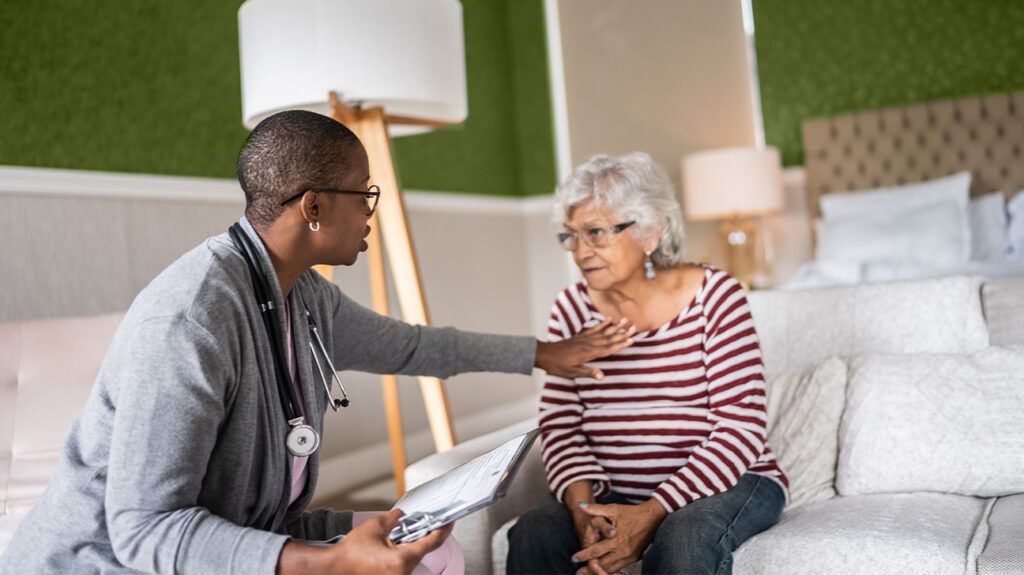Cholecystitis is inflammation of the gallbladder. One of the most common causes of gallbladder inflammation is cholelithiasis, also known as gallstones.
The gallbladder is an organ in the digestive system that stores and secretes bile, a fluid that helps break down food during digestion. However, gallstones may form and block the ducts, leading to painful and sometimes life threatening complications due to gallbladder inflammation.
Gallstones are lumps of hardened materials that form in the gallbladder and range from tiny to golf-ball-sized. These may consist of cholesterol, a waxy substance that circulates in the blood, or bilirubin, a yellow pigment that results from red blood cell breakdown. Most are painless, but some cause complications, such as cholecystitis.
This article explores cholecystitis and cholelithiasis in more detail, including their causes, symptoms, diagnosis, and treatment.

The following factors can contribute to gallstone development and gallbladder inflammation.
Cholecystitis
Two types of cholecystitis can develop, depending on the cause: calculous and acalculous.
The calculous type occurs when a gallstone or biliary sludge, a substance consisting of bile and small crystals of salt and cholesterol, blocks the cystic duct. According to the United Kingdom’s National Health Service (NHS), this accounts for about 95% of cholecystitis diagnoses.
Acalculous cholecystitis may occur due to the following, although the exact cause is not clear:
- accidental gallbladder damage during surgery
- burns
- severe injuries
- dehydration
- severe malnutrition
- sepsis
Cholelithiasis
Gallstones are common, occurring in
Certain groups of people have a higher risk of gallstones, including:
- older adults
- females, especially those who have increased levels of estrogen due to pregnancy, hormone replacement therapy, or birth control pills
- individuals with a family history of gallstones
- people of Native American and Mexican American descent
Certain health conditions also increase the risk of gallstones, such as:
Additionally, rapid weight loss due to factors like weight loss surgery might increase the risk of gallstones. Those eating a high calorie diet with high levels of refined carbohydrates and low fiber intake also have a higher risk.
When gallstones cause symptoms, they usually present as cholecystitis.
Cholecystitis
Cholecystitis mainly leads to a sharp, sudden pain toward the upper-right side of the belly, according to the NHS. This pain may feel like it is moving toward the right shoulder. The painful part of the belly may feel tender to the touch, and the pain may worsen while breathing deeply. It often lasts for longer than a few hours.
Some people experience other symptoms, such as:
A less severe, ongoing version of these symptoms may occur due to
However, severe presentations of these symptoms require urgent treatment.
Cholelithiasis
Gallstones
However, symptoms of cholecystitis may flare up due to an acute “gallbladder attack” caused by gallstones blocking the duct. These symptoms may occur in response to
A cholecystitis diagnosis often leads to tests for cholelithiasis.
Cholecystitis
Doctors
The healthcare professional will then refer the individual for gallstone testing.
Cholelithiasis
Doctors base a
- medical history — asking about certain medical conditions or family history
- physical examination, in which they will check for belly pain
- laboratory tests, including blood tests that show signs of inflammation
- imaging tests, such as ultrasound, MRI, or CT scans, to visualize the location and size of the stones
- endoscopic retrograde cholangiopancreatography
- cholescintigraphy, in which special cameras track radioactive material as it moves through the bile duct to diagnose unusual gallbladder movements or blockages
Treating both conditions often involves removing the gallbladder.
Cholecystitis
According to the NHS, people with cholecystitis usually need to stay in the hospital for around a week. However, depending on the severity of their symptoms, some may be able to return home. Cholecystitis requires urgent treatment as it may lead to severe complications, such as a ruptured gallbladder or gallbladder tissue death.
The medical team may prevent an individual from eating or drinking anything to ease pressure on the gallbladder while providing fluids to help avoid dehydration. If the doctor suspects an infection, a person may also receive pain relief medication and antibiotics.
After initial treatment, doctors may recommend removing the gallbladder to prevent further episodes of cholecystitis and reduce the risk of complications in a procedure called cholecystectomy. It is one of the
A person does not need a gallbladder to live, as bile can reach the gut through other channels.
Cholelithiasis
If gallstones do not cause symptoms, a person will not need treatment. However, if they cause a blockage contributing to cholecystitis, a person will need cholecystectomy. Nonsurgical measures may treat cholesterol stones, but bilirubin stones often require surgery.
Cholelithiasis (gallstones) is a common cause of cholecystitis, which is inflammation of the gallbladder.
Gallstones are hard lumps of cholesterol or bilirubin in the gallbladder. Many gallstones do not cause symptoms, but those that do can cause an inflamed gallbladder, which leads to cholecystitis symptoms such as sharp belly pain, fever, and nausea.
This requires urgent treatment and often leads to the removal of the gallbladder through a cholecystectomy. However, people can survive without a gallbladder, and cholecystectomies can help prevent severe complications.
